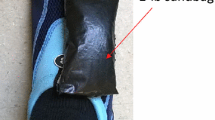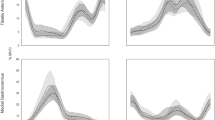Abstract
Purpose
Lateral ankle sprains are common and can manifest into chronic ankle instability (CAI) resulting in altered gait mechanics that may lead to subsequent ankle sprains. Our purpose was to simultaneously analyse muscle activation patterns and plantar pressure distribution during walking in young adults with and without CAI.
Methods
Seventeen CAI and 17 healthy subjects walked on a treadmill at 4.8 km/h. Plantar pressure measures (pressure–time integral, peak pressure, time to peak pressure, contact area, contact time) of the entire foot and nine specific foot regions and medial–lateral location of centre of pressure (COP) were measured. Surface electromyography (EMG) root mean square (RMS) amplitudes throughout the entire stride cycle and area under RMS curve for 100 ms pre-initial contact (IC) and 200 ms post-IC for anterior tibialis, peroneus longus, medial gastrocnemius, and gluteus medius were collected.
Results
The CAI group demonstrated a more lateral COP throughout the stance phase (P < 0.001 and Cohen’s d > 0.9 for all 10 comparisons) and significantly increased peak pressure (P = 0.025) and pressure–time integral (P = 0.049) under the lateral forefoot. The CAI group had lower anterior tibialis RMS areas (P < 0.001) and significantly higher peroneus longus, medial gastrocnemius, and gluteus medius RMS areas during 100 ms pre-IC (P < 0.003). The CAI group had higher gluteus medius sEMG amplitudes during the final 50 % of stance and first 25 % of swing (P < 0.05).
Conclusions
The CAI group had large lateral deviations of their COP location throughout the entire stance phase and increased gluteus medius muscle activation amplitude during late stance through early swing phase.
Level of evidence
III.



Similar content being viewed by others
References
Arnold BL, Wright CJ, Ross SE (2011) Functional ankle instability and health-related quality of life. J Athl Train 46(6):634–641
Beckman SM, Buchanan TS (1995) Ankle inversion injury and hypermobility: effect on hip and ankle muscle electromyography onset latency. Arch Phys Med Rehabil 76(12):1138–1143
Beynnon BD, Murphy DF, Alosa DM (2002) Predictive factors for lateral ankle sprains: a literature review. J Athl Train 37:376–380
Brown C (2011) Foot clearance in walking and running in individuals with ankle instability. Am J Sports Med 39:1769–1776
Carcia CR, Martin RL, Drouin JM (2008) Validity of the foot and ankle ability measure in athletes with chronic ankle instability. J Athl Train 43:179–183
Chinn L, Dicharry J, Hertel J (2013) Ankle kinematics of individuals with chronic ankle instability while walking and jogging on a treadmill in shoes. Phys Ther Sport 14(4):232–239
Cohen J (1988) Statistical power analysis for the behavioral sciences. Routledge, London
Delahunt E, Monaghan K, Caulfield B (2006) Altered neuromuscular control and ankle joint kinematics during walking in subjects with functional instability of the ankle joint. Am J Sports Med 34(12):1970–1976
Donahue M, Simon J, Docherty CL (2013) Reliability and calidity of a new questionnaire created to establish the presence of functional ankle instability: the IdFAI. Athl Train Sports Health Care 5(1):38–43
Drewes LK, McKeon PO, Casey Kerrigan D, Hertel J (2009) Dorsiflexion deficit during jogging with chronic ankle instability. J Sci Med Sport 12(6):685–687
Feger MA, Donovan L, Hart JM, Hertel J (2015) Lower extremity muscle activation in patients with or without chronic ankle instability. J Athl Train 50(4):350–357
Friel K, McLean N, Myers C, Caceres M (2006) Ipsilateral hip abductor weakness after inversion ankle sprain. J Athl Train 41(1):74–78
Gerber JP, Williams GN, Scoville CR, Arciero RA, Taylor DC (1998) Persistent disability associated with ankle sprains: a prospective examination of an athletic population. Foot Ankle Int 19(10):653–660
Gigi R, Haim A, Luger E et al (2015) Deviations in gait metrics in patients with chronic ankle instability: a case–control study. J Foot Ankle Res 8(1):1. doi:10.1186/s13047-014-0058-1
Godin G, Jobin J, Bouillon J (1985) Assessment of leisure time exercise behavior by self-report: a concurrent validity study. Can J Public Health 77(5):359–362
Gribble PA, Delahunt E, Bleakley C et al (2013) Selection criteria for patients with chronic ankle instability in controlled research: a position statement of the international ankle consortium. J Orthop Sports Phys Ther 43(8):585–591
Herb CC, Chinn L, Dicharry J, McKeon PO, Hart JM, Hertel J (2014) Shank-rearfoot joint coupling with chronic ankle instability. J Appl Biomech 30(3):366–372
Hopkins J, Coglianese M, Glasgow P, Reese S, Seeley MK (2012) Alterations in evertor/invertor muscle activation and center of pressure trajectory in participants with functional ankle instability. J Electromyogr Kinesiol 22(2):280–285
Hopkins WG, Marshall SW, Batterham AM, Hanin J (2009) Progressive statistics for studies in sports medicine and exercise science. Med Sci Sports Exerc 41(1):3–13
Hsiao H, Guan J, Weatherly M (2002) Accuracy and precision of two in-shoe pressure measurement systems. Ergonomics 45:537–555
Kernozek TW, LaMott EE, Dancisak MJ (1996) Reliability of an in-shoe pressure measurement system during treadmill walking. Foot Ankle Int 17:204–209
Konradsen L (2002) Factors contributing to chronic ankle instability: kinesthesia and joint position sense. J Athl Train 37:381–385
Konradsen L, Voigt M (2002) Inversion injury biomechanics in functional ankle instability: a cadaver study of simulated gait. Scand J Med Sci Sports 12(6):329–336
Martin RL, Irrgang JJ, Burdett RG, Conti SF, Van Swearingen JM (2005) Evidence of validity for the foot and ankle ability measure (FAAM). Foot Ankle Int 26:968–983
McKay GD, Goldie PA, Payne WR, Oakes BW (2001) Ankle injuries in basketball: injury rate and risk factors. Br J Sports Med 35:103–108
McKeon PO, Hertel J (2008) Systematic review of postural control and lateral ankle instability, Part I: can deficits be detected with instrumented testing. J Athl Train 43(3):293–304
Monaghan K, Delahunt E, Caulfield B (2006) Ankle function during gait in patients with chronic ankle instability compared to controls. Clin Biomech 21(2):168–174
Morrison KE, Hudson DJ, Davis IS et al (2010) Plantar pressure during running in subjects with chronic ankle instability. Foot Ankle Int 31(11):994–1000
Murley GS, Menz HB, Landorf KB, Bird AR (2010) Reliability of lower limb electromyography during overground walking: a comparison of maximal- and sub-maximal normalisation techniques. J Biomech 43:749–756
Nawata K, Nishihara S, Hayashi I, Teshima R (2005) Plantar pressure distribution during gait in athletes with functional instability of the ankle joint: preliminary report. J Orthop Sci 10(3):298–301
Neumann DA (2013) Kinesiology of the musculoskeletal system: foundations for rehabilitation. Elsevier Health Sciences, Amsterdam
Nyska M, Shabat S, Simkin A, Neeb M, Matan Y, Mann G (2003) Dynamic force distribution during level walking under the feet of patients with chronic ankle instability. Br J Sports Med 37(6):495–497
Schmidt H, Sauer LD, Lee SY, Saliba S, Hertel J (2011) Increased in-shoe lateral plantar pressures with chronic ankle instability. Foot Ankle Int 32(11):1075–1080
Valderrabano V, Hintermann B, Horisberger M, Fung TS (2006) Ligamentous posttraumatic ankle osteoarthritis. Am J Sports Med 34(4):612–620
Waterman BR, Owens BD, Davey S, Zacchilli MA, Philip J, Belmont J (2010) The epidemiology of ankle sprains in the United States. J Bone Joint Surg 92(13):2279–2284
Webster KA, Gribble PA (2013) A comparison of electromyography of gluteus medius and maximus in subjects with and without chronic ankle instability during two functional exercises. Phys Ther Sport 14(1):17–22
Weiss LD, Weiss JM, Silver JK (2015) Easy EMG: a guide to performing nerve conduction studies and electromyography. Elsevier Health Sciences, Amsterdam, pp 225–268
Acknowledgments
The study protocol was approved by the University of Virginia Institutional Review Board in compliance with all applicable federal regulations governing the protection of human subjects.
Author information
Authors and Affiliations
Corresponding author
Ethics declarations
Conflict of interest
None.
Disclosure statement
The views expressed in this article are those of the author(s) and do not necessarily reflect the official policy or position of the Department of the Navy, Department of Defense, or the US Government. Lieutenant Commander John J. Fraser is a military service member, and this work was prepared as part of his official duties. Title 17, USC, §105 provides that ‘Copyright protection under this title is not available for any work of the US Government’. Title 17, USC, §101 defines the US Government work as a work prepared by a military service member or employee of the US Government as part of that person’s official duties.
Rights and permissions
About this article
Cite this article
Koldenhoven, R.M., Feger, M.A., Fraser, J.J. et al. Surface electromyography and plantar pressure during walking in young adults with chronic ankle instability. Knee Surg Sports Traumatol Arthrosc 24, 1060–1070 (2016). https://doi.org/10.1007/s00167-016-4015-3
Received:
Accepted:
Published:
Issue Date:
DOI: https://doi.org/10.1007/s00167-016-4015-3




